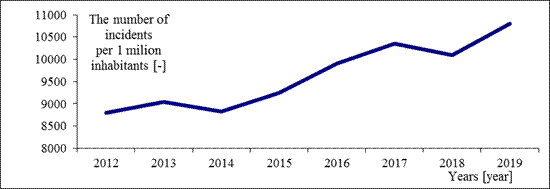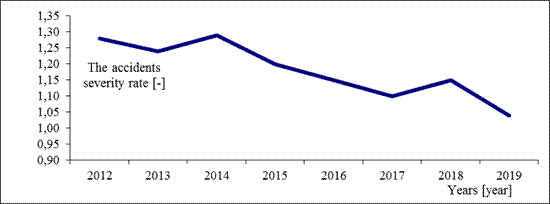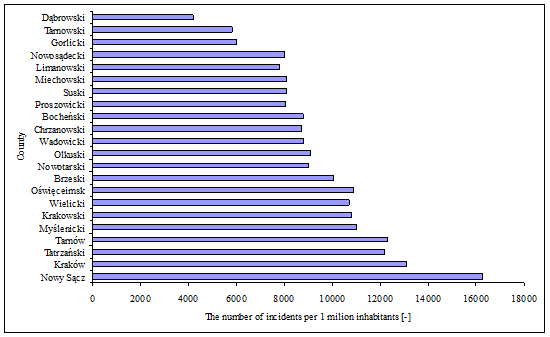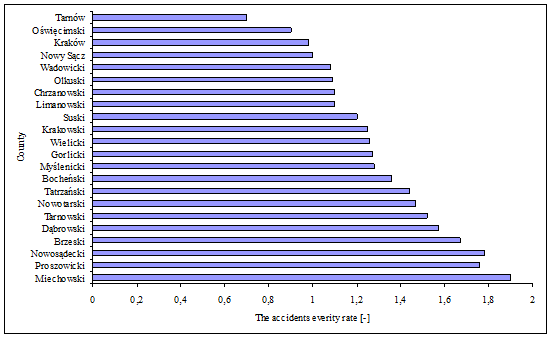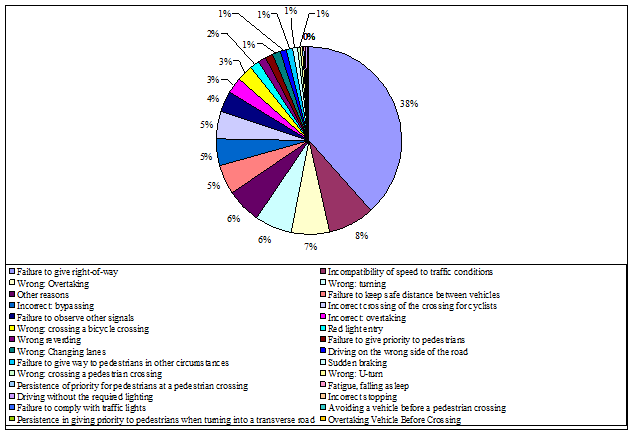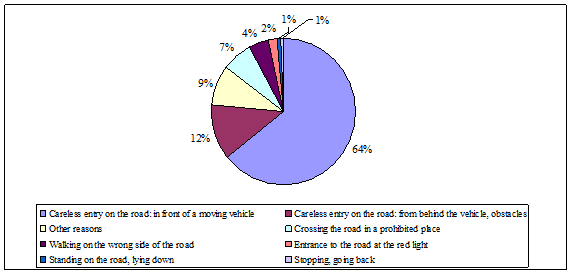Article citation information:
Macioszek, E.,
Wyderka, A., Jurdana, I. The bicyclist safety analysis based on road incidents
maps. Scientific Journal of Silesian
University of Technology. Series Transport. 2025, 126, 129-147. ISSN: 0209-3324. DOI: https://doi.org/10.20858/sjsutst.2025.126.8.
Elżbieta
MACIOSZEK[1], Agata WYDERKA[2], Irena JURDANA[3]
THE BICYCLIST SAFETY ANALYSIS BASED ON
ROAD INCIDENTS MAPS
Summary. Increasing
road congestion leads to frustration and irritation of drivers, which often
contributes to dangerous driving maneuvers. This causes dangerous situations -
collisions or road accidents. The driver, while moving the car, is protected by
the vehicle body and, above all, by the crumple zone. Unprotected road users,
such as pedestrians or cyclists, usually do not have any protection. The
article aims to assess the state of bicycle traffic safety in the Małopolskie
Voivodeship in 2012-2019. This assessment was made based on road incident maps.
In the first stage of work, the indicators for the number of incidents per 1
million inhabitants and the severity of the incidents were calculated for the
entire Małopolskie Voivodeship and particular counties in 2012-2019. The data
from the Accident and Collision Record System and the Central Statistical
Office were used for this purpose. Then, the safety of bicycle traffic in the
Małopolskie Voivodeship was analyzed based on the developed road incident maps.
Although the number of road incidents increases from year to year in the
analyzed period, they are less severe over time. Presenting road incidents data
on maps allows for the highlighting of critical locations on the city's
transport network from the point of view of cyclists' safety.
Keywords: road
safety, bicycle traffic, road incident map, road traffic engineering
1.
INTRODUCTION
The bicycle has become an integral element of the
transport system of many cities around the world. National strategies assume a
significant increase in the use of bicycles as a means of transport, and for
tourism purposes, which is usually accompanied by plans to develop
infrastructure for cycling. The increase in the use of bicycles as a means of
transport and recreation is observed especially in cities and agglomerations,
where a significant part of the travel distance does not exceed
However, despite the many benefits of cycling, many
scientific works indicate that concerns about the safety of cycling constitute
one of the greatest obstacles to the widespread adoption of cycling as an
alternative to the use of private vehicles [5], [18]. Cyclists are among the
most vulnerable road users, and in the event of a road accident with a motor
vehicle, they are the ones who suffer the most serious injuries. Moreover, the
World Health Organization (WHO) [17] reported that in 2021 more than half of
all road traffic deaths were among vulnerable road users, i.e., pedestrians, cyclists,
and motorcyclists. There may be many reasons for this state of affairs. The
geometric shape of roads has a significant impact on cyclists' safety. Proper
planning of roads and infrastructure for cyclists is a fundamental activity
influencing their effective and safe use by cyclists. Ideally, roads should be
designed with the safety of all road users. This would mean providing
appropriate infrastructure not only for vehicle drivers but also for
pedestrians, cyclists, and motorcyclists. Measures such as pedestrian paths,
cycle lanes, safe crossings, and other traffic-calming measures can be crucial
to reducing the risk of injury among these road users.
The aim of all actions taken to improve road safety is
to reduce the number of accidents and their victims. It is becoming more and
more common to strive not only to improve the situation, but also to completely
eliminate road accidents, i.e., the implementation of the so-called Vision Zero
[14]. People have the right to make mistakes, and a safe transport system
should provide its users with the ability to move comfortably, but at the same
time safely. Achieving such a goal requires taking many actions, the
effectiveness of which largely depends on the identification of particularly
dangerous places where a large number of road accidents are recorded. In
practice, various research methods can be used to find particularly dangerous
places and identify the causes of road accidents, such as analyzes of data on
road accidents and collisions based on data collected by the police, detailed
studies of the most serious accidents, observations of road users' behavior,
audits and road traffic safety control, conducting public consultations.
In world literature, we can find many works dedicated
to road traffic safety. These works are devoted to safety, among others various
road users [3], [9], safety level on various elements of the transport network
[4], [11], [19], in built-up areas, and outside of them [7], [8]. The aim of
the article is to analyze the safety of bicycle traffic in the Małopolskie
Voivodeship in Poland in the years 2012-2019. This analysis was carried out
based on the developed maps of road incidents. The second section, after the
introduction, presents the methodology for conducting research. The third
section presents an analysis of selected road safety measures for the studied
area. This section analyzed the number of accidents per 1 million inhabitants
for the entire Małopolskie Voivodeship, and for individual counties during the
analysis period. Then, the accident severity index was analyzed for the entire
Małopolskie Voivodeship, and for individual counties. For this purpose, data
from the Accident and Collision Registration System, and from the Central
Statistical Office (in Polish: GUS) were used [15]. The next, fourth section
presents an assessment of the safety level of bicycle traffic in the
Małopolskie Voivodeship based on the developed maps of road accidents, and maps
of road accident victims. The last section contains conclusions from the
analyses presented in the article.
2. METHODOLOGY OF THE CONDUCTED
RESEARCH
The area of analysis was the
Małopolskie Voivodeship, which, apart from three other voivodeships in Poland
such as Silesia, Podkarpackie, and Pomerania, is included in the group of
voivodeships in which in recent years the highest share of fatalities in road
accidents in built-up areas has been recorded (as much as 72%) [16]. In order
to assess the safety level of bicycle traffic in the Małopolskie Voivodeship in
the years 2012-2019, first of all, an analysis of the most important
characteristics of road incidents with cyclists was carried out, such as:
· indicators: the number of incidents
per 1 million inhabitants, and the severity of incidents for the entire
voivodeship in the subsequent years of the analysis, and with precision to the
poviat,
· distribution of road incidents
involving cyclists,
· characteristics of the incident
location, and the vehicles of the incident participants with cyclists,
· distribution of causes of road
incidents involving cyclists due to the fault of vehicle drivers, and
pedestrians.
The number of incidents per 1
million inhabitants was calculated based on the following formula [13]:
![]() (1)
(1)
where:
WM -
the number of incidents per 1 million inhabitants,
Z -
the total number of incidents in the analyzed period,
M -
the number of inhabitants.
In turn, the formula [13] was used
to calculate the incidents’ severity index:
![]() (2)
(2)
where:
WC -
incident severity index,
Y -
number of incidents in the analysis period,
X -
the equivalent number of incidents.
The value of the equivalent number
of road incidents is determined from the formula:
![]() (3)
(3)
where:
xi -
conversion factor of a given i-th road incident into the number of
equivalent road incidents calculated from the equation:
![]() (4)
(4)
where:
![]() -
the number of fatalities, seriously injured people, slightly injured people,
and vehicles damaged as a result of the incident, respectively,
-
the number of fatalities, seriously injured people, slightly injured people,
and vehicles damaged as a result of the incident, respectively,
qz, qH,
qR, qP -
the weight of individual effects of road incidents due to the occurrence of
specific effects of a road incident in relation to the costs of an average road
collision.
Table 1 presents the values of the weights of
individual effects of road incidents due to the occurrence of specific effects
of road incidents in relation to the costs of an average road collision. The
weight values were adopted on the basis of data presented in the research work
of T. Szczuraszek [13].
Tab. 1
The values of
the weights of individual effects of road incidents due to the occurrence of
specific effects of a road incident in relation to the costs of an average road
collision
|
Individual effect of a road
accident |
The values of the weights |
|
Fatal injury |
26,7 |
|
Serious injury |
10,0 |
|
Slightly injury |
0,5 |
|
Damage
to a vehicle involved in the accident |
1,0 |
|
Damage
to the vehicle involved in the collision |
0,5 |
In addition, maps of the
concentration of road incidents, and maps of the concentration of road accident
victims were developed, down to the poviat, representing:
· the number of road incidents
involving cyclists,
· the number of people slightly
injured in road accidents involving cyclists,
· the number of people seriously
injured in road accidents involving cyclists,
· the number of fatalities in road
accidents involving cyclists.
The maps were prepared on the basis
of data obtained from the Accident and Collision Registration System database.
The data were grouped into classes depending on the number of the examined
feature per year. Maps were made separately for each year of analysis, as well
as jointly for the analyzed period. Due to the limitations of the article's
volume, the article presents only summary maps for the total period.
From a cognitive point of view, the
most valuable part of the work is the development of maps representing the
location:
· road accidents resulting in slightly
injured victims,
· road accidents resulting in
seriously injured victims,
· road accidents resulting in
fatalities.
These maps allow the identification
of the most dangerous locations on the road network where road accidents with
victims occur. Knowledge of these places allows taking preventive actions
regarding the reconstruction of road infrastructure or the introduction of
measures to improve road safety.
3. ANALYSIS OF SELECTED MEASURES OF CYCLING SAFETY IN THE MAŁOPOLSKIE
VOIVODESHIP
The Małopolskie Voivodeship is
located in the southern part of Poland. It is divided into nineteen counties
and three communes with county rights. Firstly, two indicators were used to
analyze road incidents in the Małopolskie Voivodeship in 2012-2019: the indicator
of the number of incidents per 1 million inhabitants, and the incident severity
indicator (Fig. 1).
In the analyzed period, the number
of road incidents per 1 million inhabitants in the Małopolskie Voivodeship
increased by approximately
Figure 2a shows the number of road
incidents per 1 million inhabitants in individual counties in the Małopolskie
Voivodeship during the analysis period. The greatest number of road incidents
per 1 million inhabitants during the analysis period took place in the city of
Nowy Sącz, while the least in Dąbrowa County. The variability of the incident
severity index in individual counties in the Małopolskie Voivodeship during the
analyzed period has been presented in the Figure 2b. The highest value of the
road accident severity index can be observed for the Miechów poviat, while the
lowest for the city of Tarnów. It can also be stated that individual poviats
are characterized by high values of the number of road incidents per 1 million
inhabitants. The lowest values of the incident severity index were recorded for
the Tarnów, Oświęcim, and Krakow counties.
During the analyzed period, there
were 8,105 incidents involving cyclists in the Małopolskie Voivodeship. In
these incidents, 2,613 people were slightly injured, 1,366 people were
seriously injured, and 136 suffered fatal injuries (Fig. 3). In turn, analyzing
the distribution of types of road incidents involving cyclists, it can be
concluded that side collisions of vehicles dominated, accounting for almost 58%
of all incidents. Then there were incidents such as vehicle rollover (11.19%),
rear collision (7.58%), frontal collision (6.70%), others (5.66%). The share of
other types of incidents was less than 5%.
|
a) |
|
|
|
b) |
|
|
Fig. 1. (a) Distribution of the
number of road incidents involving cyclists per 1 million inhabitants, b)
Incident severity index in the Małopolskie Voivodeship in the analyzed period
Descriptive statistics of incidents
in the analyzed period also allow the conclusion that, taking into account the
characteristics of the place of the incident, most of them took place on the
road (69,90%). Much less on the sidewalk, pedestrian path (7,08%), cyclist
crossing (5,75%), cyclist road (4,70%), pedestrian crossing (4,55%), road,
traffic lane, bicycle lock (2,87%), in the area of entry and exit from the
property (2,49%). The share of incidents involving cyclists in other parts of
the transport network was negligible (< 1,0%). In turn, taking into account
the type of intersection where an incident involving a cyclist occurred, it can
be concluded that most incidents took place at intersections without traffic
lights (as many as 88,51%), much less at intersections with circular traffic
(8,32%), and at other intersections (3,18%). Taking into account the vehicles
of the incidents participants with cyclists, it should be stated that in the
vast majority of cases, incidents occurred between cyclists and passenger cars
(as many as 88% of cases), then with heavy vehicles over 3.5 tons (2,64%), and
with heavy vehicles up to 3,5 tons (2,07%). The share of incidents between
cyclists and other types of vehicles was less than 1,0%.
Fig. 4 shows the distribution of
causes of road accidents involving cyclists due to the fault of drivers (Fig.
4a), and due to the fault of pedestrians (Fig. 4b) in the Małopolskie
Voivodeship in the years 2012-2019. The most common cause of accidents in the
case of accidents between cyclists and motor vehicles was failure to give way
(38,24%). Then, failure to adjust speed to traffic conditions (8,17%),
incorrect overtaking (6,62%), incorrect turning (6,44%), failure to maintain a
safe distance between vehicles (5,06%). The share of other causes of accidents
with cyclists due to drivers' fault was less than 5%. However, the most common
accidents involving cyclists were due to the fault of pedestrians when a
pedestrian entered the road in front of a moving bicycle (64,10%), carelessly
entered the road from behind a vehicle or an obstacle (12,18%), or when
pedestrians crossed the road in an unauthorized place (7,05%). The share of
other causes of cyclist-pedestrian accidents due to pedestrians' fault did not
exceed 5%.
|
a) |
|
|
b) |
|
Fig. 2. (a) Distribution of the
number of road incidents involving cyclists per 1 million inhabitants, b)
Incident severity index in individual poviats in
the Małopolskie Voivodeship in the analyzed period

Fig. 3. Distribution of road
incidents involving cyclists in
the Małopolskie Voivodeship in the analyzed period
Source: own study based on data from
the Accident
and Collision Registration System database [1]
|
a) |
|
|
b) |
|
Fig. 4. Causes of road accidents
involving cyclists in the Małopolskie Voivodeship in the analyzed period
(a) due to the fault of the vehicle drivers, (b) due to pedestrians' fault
4. ASSESSMENT OF THE CYCLING SAFETY IN THE MAŁOPOLSKIE VOIVODESHIP BASED
ON ACCIDENTS MAPS
In a further stage of work, maps of
road accidents and maps of road accident victims were developed. In each
analyzed year, the largest number of road incidents involving cyclists occurred
in Kraków (Figure 5). Kraków is a tourist city with high levels of road
traffic. In Kraków, the most incidents involving cyclists took place in 2019,
and there were 483 road incidents. The fewest incidents were recorded in the Miechowski
and Proszowicki counties (44 and 47 respectively). There is variability in the
number of road incidents in particular counties in the analyzed period, except
for the city of Kraków and the Proszowicki county. The lowest number of
incidents involving cyclists was recorded in 2012 (894 incidents).
Figure 6 presents the number of
people slightly injured in road accidents involving cyclists in the analyzed
period in the Małopolskie Voivodeship. The largest number of slightly injured
persons in the city of Kraków was recorded in 2016 (175 slightly injured). The
largest number of people slightly injured in road accidents in the entire
voivodeship was recorded in 2014 (366 slightly injured, and the least in 2017
(307 slightly injured). The smallest number of slightly injured (less than 30)
was recorded in the counties: Proszowicki, Miechowski, Limanowski, and Suski.
Similarly, as in the case of the number of road incidents in the analyzed
period, there is a variation in the number of slightly injured persons in road
incidents in particular counties, except the city of Kraków and Proszowicki
county. The largest number of seriously injured individuals was recorded in the
city of Kraków in 2016 (83 seriously injured) (Figure 7). The smallest number
of seriously injured persons (less than 20) was recorded in the following
counties: Miechowski, Suski, Proszowicki, Gorlicki, Dąbrowski, and Limanowski.
The lowest number of seriously injured people was recorded in 2017 (155), while
the highest number in 2014 (196). There is variability in the number of road
incidents in particular counties, except the city of Kraków and counties: the
city of Olkusz, Miechowski, Proszowicki, Suski, Limanowski, and Gorlicki.
Figure 8 presents maps with the number of fatal victims in road accidents
involving cyclists in the Małopolskie Voivodship in the analyzed period. In
each case, the variability of the number of fatalities in particular years in
each of the counties is visible. The largest number of fatal victims (7 fatal
victims) was recorded in Wielicki county in 2014. The lowest number of
fatalities (2 fatal victims) was recorded in the following counties: Dąbrowski,
Limanowski, and Proszowicki. The highest number of fatal victims in road
accidents involving cyclists (25 fatal victims) was recorded in 2014, and the
lowest (13 fatal victims) in 2016.
a)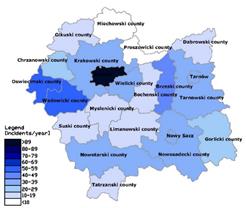 b)
b)
c) d)
d)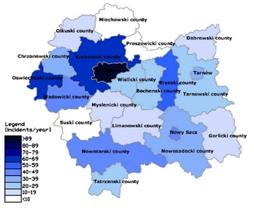
e)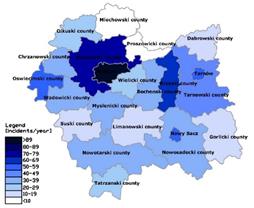 f)
f)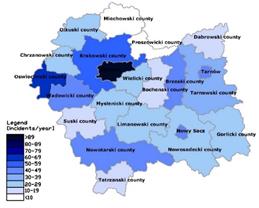
g)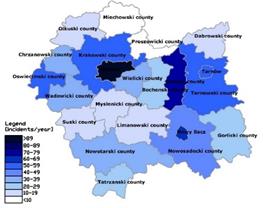 h)
h)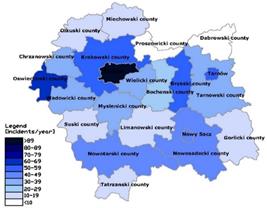
Fig. 5. Maps of road incidents
involving cyclists in the Małopolskie Voivodeship in the analyzed period;
a) 2012, b) 2013, c) 2014, d) 2015, e) 2016, f) 2017, g) 2018, h) 2019
a)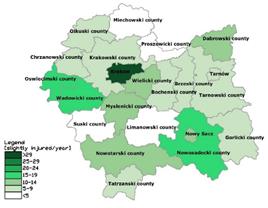 b)
b)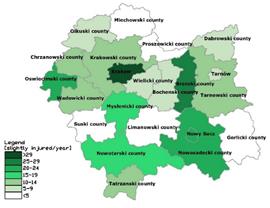
c) d)
d)
e)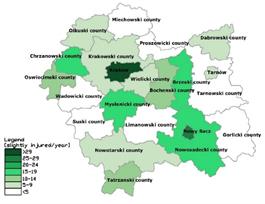 f)
f)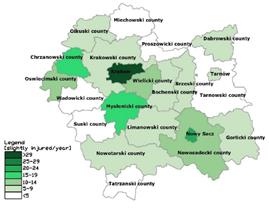
g)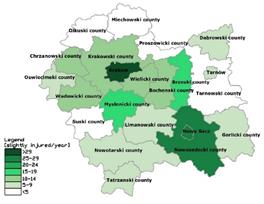 h)
h)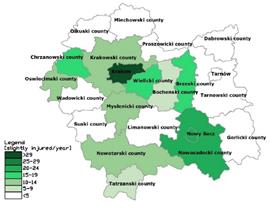
Fig. 6. Maps showing the number of
people slightly injured in road accidents involving cyclists in the Małopolskie
Voivodeship in the analyzed period; a) 2012, b) 2013, c) 2014, d) 2015, e)
2016, f) 2017, g) 2018, h) 2019
a)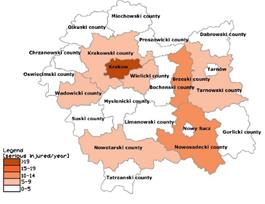 b)
b)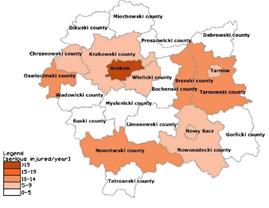
c) 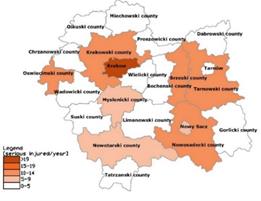 d)
d)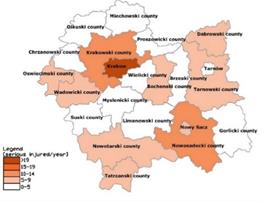
e) f)
f)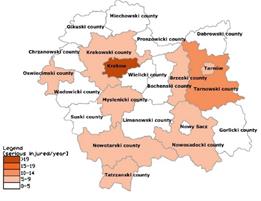
g)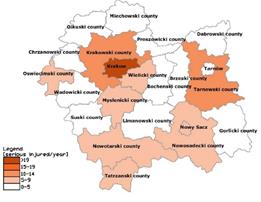 h)
h)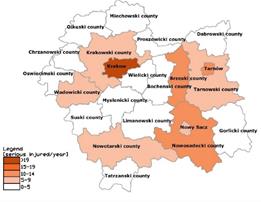
Fig. 7. Maps showing the number of
seriously injured people in road accidents involving cyclists in the
Małopolskie Voivodeship in the analyzed period; a) 2012, b) 2013, c) 2014,
d) 2015, e) 2016, f) 2017, g) 2018, h) 2019
a)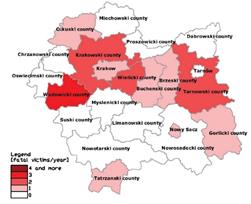 b)
b)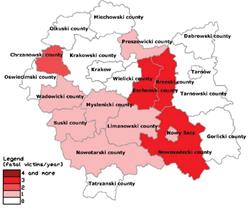
c)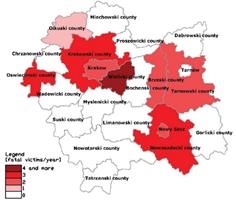 d)
d)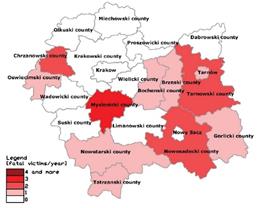
e)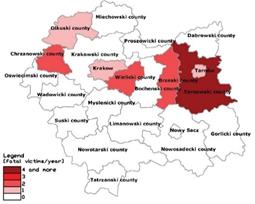 f)
f)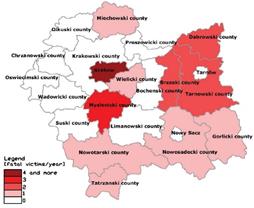
g) h)
h)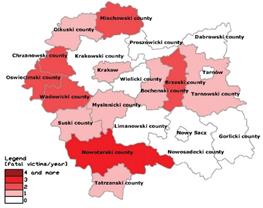
Fig. 8. Maps showing the number of
fatal victims in road accidents involving cyclists in the Małopolskie
Voivodeship in the analyzed period; a) 2012, b) 2013, c) 2014, d) 2015,
e) 2016, f) 2017, g) 2018, h) 2019
Figure 9 presents the location of
road accidents in the Małopolskie Voivodeship in the analyzed period, as a
result of which individuals were slightly injured. The highest density of road
accidents was in the city of Kraków (Figure 9). However, the smallest in the
central and northern part of the voivodeship, where counties such as:
Proszowicki, Miechowski, Limanowski, and Suski. The presented locations of road
incidents in which slightly injured persons were reported are related to the
data presented in Figure 6. The lowest concentration of markers representing
the location of the incidents can be observed in those counties with the lowest
number of slightly injured people.
In the case of road accidents in
which the victims suffered injuries classified as severe (seriously injured),
the highest density of markers occurs in the city of Krakow. The smallest
density of markers occurs in counties such as: Miechowski, Suski, Proszowicki,
Gorlicki, Dąbrowski and Limanowski (Figure 10).
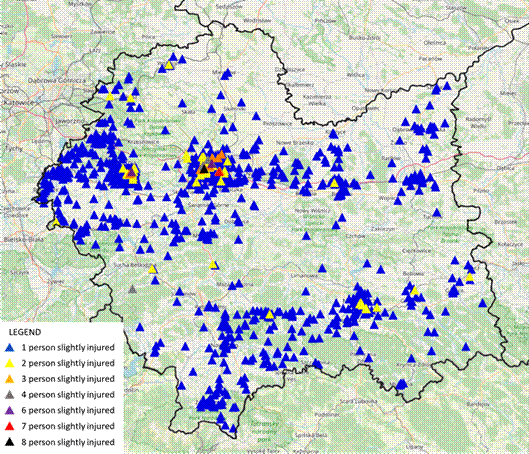
Fig. 9. Location of road accidents
with slightly injured in the Małopolskie voivodship in the analyzed period
On the other hand, in the case of
road accidents resulting in fatal victims, one accident occurred most
frequently in the given locations, and only in a few cases – two accidents
(Figure 11). Presentation of data on road incidents in this way (Figures
from 9 to 11) allows for the identification of sensitive places (areas, roads,
streets, intersections, etc.) on the city's transport network from the point of
view of cyclists' safety. At a later stage, it is possible to analyze and
search for solutions that may contribute to the improvement of road safety.
5. CONCLUSIONS
The article aimed to analyze the
cycling safety in the Małopolskie Voivodeship based on road incident maps. The
results of the analyses presented in the article allowed for the formulation of
the following conclusions:
·
in
the analyzed period, the number of incidents is increasing based on the values
of the indicators: the number of incidents per 1 million inhabitants and the
severity of the incidents for the Małopolskie Voivodeship. Despite the increase
in the number of incidents, the incidents’ severity indicator in the
Małopolskie Voivodeship is decreasing, which should be considered a positive
effect of all activities aimed at improving road safety,
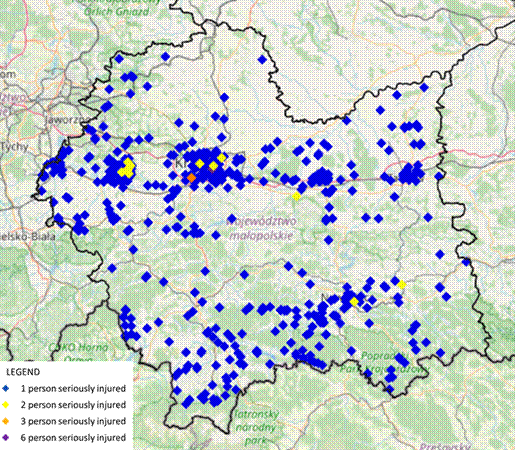
Fig. 10. Location of road accidents
with seriously injured victims in the Małopolskie Voivodeship in the analyzed
period
·
Cracow
is characterized by the highest number of road incidents, slightly injured
people, and seriously injured individuals,
·
the
lowest number of road incidents involving cyclists took place in the Miechowski
and Proszowicki counties,
·
the
lowest number of people slightly injured in road incidents involving cyclists
was recorded in the following counties: Proszowicki, Miechowski, Limanowski,
and Suski. On the other hand, the lowest number of seriously injured persons
was recorded in the following counties: Miechowski, Suski, Proszowicki,
Gorlicki, Dąbrowski, and Limanowski,
·
Wielicki
county is characterized by the highest number of fatalities in road accidents
involving cyclists. On the other hand, the lowest number of fatal victims was
recorded in the counties: Dąbrowski, Limanowski, and Proszowicki,
·
Presenting
road incidents’ data on maps allows for the highlighting of critical locations
on the city's transport network from the point of view of cyclists' safety. The
information obtained in this way allows for taking actions aimed at improving
the state of road safety.
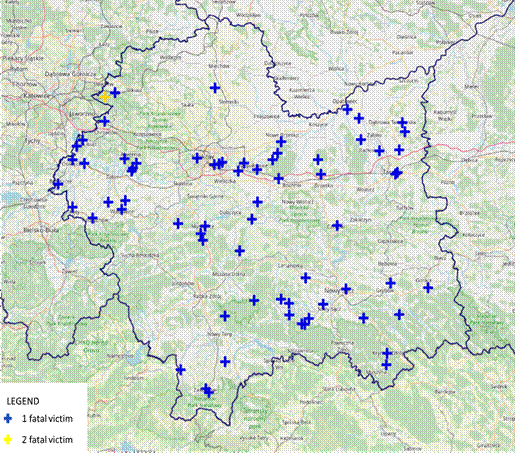
Fig. 11. Location of road accidents
with fatal victims in the Małopolskie Voivodeship in the analyzed period
Acknowledgments
This publication is supported by the Rector’s
Pro-Quality Grant, Silesian University of Technology grant number 12/040/RGJ24/0064, and Silesian University of Technology
grant number BK-285/RT4/2024, 12/040/BK_24/0065.
References
1.
ACRS. ,,Accident and Collision Registration
System”. Available at: http://sewik.pl/search.
2.
Cai Qing, Mohamed
Abdel-Aty, Scott Castro. 2020. ,,Explore effects of bicycle facilities and
exposure on bicycle safety at intersections”. International Journal of Sustainable Transportation 15(8): 592-601.
ISSN: 1556-8318. DOI: 10.1080/15568318.2020.1772415.
3.
Chebanyuk Kateryna, Oleksii Prasolenko, Dmytro Burko, Andrii
Galkin, Oleksii Lobashov, Anastasia Shevchenko, Davide Shingo Usami, Luca
Persia. 2020. ,,Pedestrians influence on the
traffic flow parameters and road safety indicators at the pedestrian
crossing". Transportation Research Procedia 45: 858-865. ISSN: 2352-1465. DOI: 10.1016/j.trpro.2020.02.083.
4.
D'Andrea Eleonora, Francesco
Marcelloni. 2017. ,,Detection of traffic congestion and incidents from GPS
trace analysis”. Expert Systems with Applications 73: 43-56. ISSN: 0957-4174. DOI:
10.1016/j.eswa.2016.12.018.
5.
Ding Hongliang, Nn Sze, Yanyong
Guo, Haojie Li. 2021. ,,Role of exposure in bicycle safety analysis: Effect of
cycle path choice”. Accident Analysis
& Prevention 153:1-11. ISSN: 1879-2057. DOI: 10.1016/j.aap.2021.106014.
6.
Jacyna
Marianna, Emilian Szczepański, Konrad Lewczuk, Mariusz Izdebski, Ilona Jacyna-Gołda,
Michał Kłodawski, Paweł Gołda, Piotr Gołębiowski. 2021. ,,Noise
pollution from transport”. International
Encyklopedia of Transportation 1-7: 277-284. ISBN: 0323913334. DOI:
10.1016/B978-0-08-102671-7.10723-7.
7.
Kraidi Raid, Harry Evdorides.
2020. ,,Pedestrian safety models for urban environments with high roadside
activities". Safety Science 130: 1-8. ISSN:
1879-1042. DOI: 10.1016/j.ssci.2020.104847.
8.
Llopis-Castelló David, Daniel
J. Findley, Alfredo García. 2021. ,,Comparison of the highway safety manual
predictive method with safety performance functions based on geometric design
consistency”. Journal of Transportation Safety & Security 13(12):
1365-1386. DOI: 10.1080/19439962.2020.1738612.
9.
Matsui Yashiro, Shoko
Oikawa, Masahito Hitosugi. 2016. ,,Analysis of car-to-bicycle approach patterns
for developing active safety devices”. Traffic Injury Prevention 17: 434-439. ISSN: 1538-957X. DOI: 10.1080/15389588.2015.1087641.
10. Mueller
Natalie, David Rojas-Rueda, Tom Cole-Hunter, Audrey de Nazelle, Evi Dons, Regine
Gerike, Thomas Gotschi, Luc Int Panis, Sonja Kahlmeier, Mark Nieuwenhuijsen.
2015. ,,Health impact assessment of active
transportation: A systematic review”. Preventive Medicine 76: 103-114. ISSN: 0091-7435. DOI: 10.1016/j.ypmed.2015.04.010.
11.
Ren Jianqiang, Yangzhou Chen,
Le Xin, Jianjun Shi, Baotong Li, Yinan Liu. 2016. ,,Detecting and positioning
of traffic incidents via video-based analysis of traffic states in a road
segment”. IET Intelligent Transport Systems 10(6): 428-437. ISSN: 1751-956X. DOI: 10.1049/iet-its.2015.0022.
12. Staniuk Wiesław, Michał Staniuk,
Norbert Chamier-Gliszczynski, Marianna Jacyna, Michał Kłodawski. 2022.
,,Decision-Making under the Risk, Uncertainty and Covid-19 Pandemic Conditions
Applying the PL9A Method of Logistics Planning - Case Study”. Energies
15(2): 1-23. ISSN: 1996-1073. DOI: 10.3390/en15020639.
13. Szczuraszek Tomasz. 2005. Municipal
Traffic Safety. Warsaw: Publishing
House of Communications. ISBN:
978-83-206-1557-9.
14.
Vision Zero. Available at: http://www.welivevisionzero.com/vision-zero/.
15.
Website of the Central Statistical Office.
Available at: https://stat.gov.pl/.
16.
Website of the Republic of Poland. ,,Guidelines
for safe cycling”. Available at:
https://www.gov.pl/web/infrastruktura/wytyczne-bezpiecznego-ruchu-rowerowego.
17.
WHO. ,,World Healts
Organization". Available at:
https://www.who.int/news-room/fact-sheets/detail/road-traffic-injuries.
18.
Yasmin Shamsunnahar, Naveen
Eluru. 2016. ,,Latent segmentation based count models: Analysis of bicycle
safety in Montreal and Toronto”. Accident
Analysis & Prevention 95: 157-171. ISSN: 1879-2057. DOI: 10.1016/j.aap.2016.07.015.
19.
Zhang Kun, Michael Taylor.
2006. ,,Effective arterial road incident detection: a Bayesian network based
algorithm”. Transportation Research Part C: Emerging Technologies 14(6): 403-417. ISSN: 0968-090X. DOI:
10.1016/j.trc.2006.11.001.
Received 13.07.2024; accepted in
revised form 20.10.2024
![]()
Scientific Journal of Silesian University of Technology. Series
Transport is licensed under a Creative Commons Attribution 4.0
International License
